The Migration and Transformation of Nitrogen in the Danjiangkou Reservoir and Upper Stream: A Review
Abstract
:1. Introduction
2. Spatial-Temporal Characteristics of N in the Danjiangkou Reservoir and Upper Stream
2.1. Overview of the Danjiangkou Reservoir
2.2. Spatio-Temporal Variation Characteristics of N in the Reservoir
2.2.1. TN Concentration
2.2.2. Annual TN Fluctuations in the Reservoir
2.2.3. Seasonal TN Concentration Fluctuations in the Reservoir
2.3. Spatial-Temporal Variation Characteristics of N in the Watershed and Tributaries
2.3.1. Contribution of N to the Watershed
2.3.2. TN Load
2.3.3. Heavily Polluted Urban Rivers
2.3.4. Seasonal Variation Trend of the TN Concentration in the Inflow Tributaries
2.4. Morphological N Variations
3. Sources of N in the Water
3.1. Overall Analysis of N Pollution
3.2. Analysis of Nonpoint Source Pollution
3.2.1. Farmland as a Nonpoint Pollution Source
3.2.2. Pollution from Dispersed Livestock and Poultry Breeding
3.2.3. Land-Use Cover Change and Soil Erosion
3.3. Analysis of Endogenous Pollution
3.4. Impact of Water-Fluctuation Zone on Water Quality
3.5. Atmospheric N Deposition
4. Conclusions and Prospects
Author Contributions
Funding
Institutional Review Board Statement
Informed Consent Statement
Conflicts of Interest
Appendix A
| Author | Year | Research Method | Research Area | Indicator | Research Content |
|---|---|---|---|---|---|
| Yin et al. | 2007 | Reservoir area, tributaries entering the reservoir | TN, NH3-N | Cause and control | |
| Wang et al. | 2008 | Reservoir area, tributaries entering the reservoir | TN, NH3-N, NO3-N, NO2-N | Dynamic characteristics | |
| Tu et al. | 2010 | Arcview | Hanjiang subreservoir | TN, NH3-N, NO3-N | Nonpoint source dynamic change |
| Lei et al. | 2012 | TLI a | Tributaries entering the reservoir | TN, NH3-N, NO3-N | Dynamic characteristics |
| Li et al. | 2012 | Soil | TN, NH3-N, NO3-N | Land-use type | |
| Qiao et al. | 2013 | SWAT | Watershed of Danjiang subreservoir | Adsorbed N, dissolved N | Spatial and temporal distribution of agricultural nonpoint source |
| Zeng et al. | 2014 | Fractional leaching by N form | Water-fluctuation zone | TF-N b, IEF-N c, CF-N d, IMOF-N e, OSF-N f, NTF-N g | |
| Lei et al. | 2016 | Soil | TN, NH3-N, NO3-N, DTN h, DON i, DIN j | N loss | |
| Zhu et al. | 2016 | Reservoir area, tributaries entering the reservoir | TN, NH3-N, NO3-N, NO2-N, DTN, DON, DIN | Distribution characteristics | |
| Wang et al. | 2016 | Reservoir area, tributaries entering the reservoir | TN, NH3-N | Distribution characteristics | |
| Chen et al. | 2005, 2010 | Watershed of Danjiang subreservoir | TN, NH3-N, NO3-N, NO2-N | Dynamic characteristics | |
| Song et al. | 2006 | Tributaries entering the reservoir in Shiyan City | TN | Pollution source | |
| Song et al. | 2009 | Hanjiang subreservoir | TN, NH3-N, NO3-N, NO2-N | Pollution source | |
| Li et al. | 2009 | Reservoir area | NH3-N, NO3-N, DIN | Distribution characteristics | |
| Xiao et al. | 2013 | Soil | TN, NH3-N, NO3-N | Distribution characteristics | |
| Ai et al. | 2015 | Reservoir area, tributaries entering the reservoir | NH3-N | Spatial and seasonal pattern | |
| Zhuang et al. | 2016 | Watershed of Danjiang subreservoir | TN | Source | |
| Min et al. | 2017 | Reservoir area, tributaries entering the reservoir | TN, NH3-N, NO3-N, NO2-N | Distribution characteristics and control of N emissions | |
| Liu et al. | 2017 | Reservoir area, tributaries entering the reservoir | TN, NH3-N | Distribution characteristics | |
| Xin et al. | 2018 | Reservoir area, tributaries entering the reservoir, bays of the reservoir | TN, NH3-N, NO3-N | Pollution source | |
| Luo et al. | 2018 | Reservoir area | TN, NH3-N, NO3-N, TDN | Dry precipitation | |
| Dang et al. | 2018 | Reservoir area | TN, NH3-N, NO3-N | Sediment | |
| Yin et al. | 2018 | Water-fluctuation zone | TN | Impact of hydro-fluctuation belt | |
| Zhao et al. | 2018 | Tributaries entering the reservoir | TN | N budget load | |
| Liu et al. | 2018 | Tributaries entering the reservoir | TN, NH3-N, NO3-N, DTN, DIN | Distribution characteristics | |
| Zhang et al. | 2019 | 16S r DNA Miseq high-throughput sequencing | Reservoir area | Phytoplankton community | N cycle |
| Wang et al. | 2019 | Danjiang subreservoir | TN, NH3-N | Internal source release | |
| Lei et al. | 2019 | Around the reservoir | TN, NH3-N, NO3-N, NO2-N | Vegetative filter strip | |
| Zhu et al. | 2020 | Reservoir area, tributaries entering the reservoir | NH3-N | Dynamic characteristics | |
| Zhang et al. | 2020 | TLI | Reservoir area, tributaries entering the reservoir | TN | Evaluation of trophic state |
| Hao et al. | 2020 | Isotope, MCMC mixing model | Tributaries entering the reservoir | TN, NH3-N, NO3-N | Source, migration and transformation |
| Han et al. | 2020 | Reservoir area, tributaries entering the reservoir | TN, NH3-N, NO3-N, NO2-N | Water-sediment interface | |
| Dong et al. | 2020 | Remote sensing | Danjiang subreservoir | TN, NH3-N | Inversion |
| Li et al. | 2020 | Bays of Danjiangkou Reservoir | TN | Impact of watershed landscape |
References
- Yu, C.; Huang, X.; Chen, H.; Godfray, H.C.J.; Wright, J.S.; Hall, J.W.; Gong, P.; Ni, S.; Qiao, S.; Huang, G.; et al. Managing nitrogen to restore water quality in China. Nature 2019, 567, 516–520. [Google Scholar] [CrossRef]
- Ma, F.B.; Li, C.H.; Wang, X.; Yang, Z.F.; Sun, C.C.; Liang, P.Y. A Bayesian method for comprehensive water quality evaluation of the Danjiangkou Reservoir water source area, for the middle route of the South-to-North Water Diversion Project in China. Front. Earth Sci. 2014, 8, 242–250. [Google Scholar] [CrossRef]
- Zhu, Y.Y.; Liu, Y.; Zhou, B.H.; Jiang, Q.F.; Wu, D.W. The Temporal and Spatial Distribution of Nitrogen in Danjiangkou Reservoir Watershed Environmental Monitoring in China. Environ. Monit. China 2016, 32, 50–57. [Google Scholar]
- Li, S.Y.; Cheng, X.L.; Xu, Z.F.; Han, H.Y.; Zhang, Q.F. Spatial and temporal patterns of the water quality in the Danjiangkou Reservoir, China. Hydrol. Sci. J. 2009, 54, 124–134. [Google Scholar] [CrossRef]
- Chen, Z.J.; Yuan, J.; Sun, F.; Zhang, F.; Chen, Y.; Ding, C.Y.; Shi, J.W.; Li, Y.Y.; Yao, L.G. Planktonic fungal community structures and their relationship to water quality in the Danjiangkou Reservoir, China. Sci. Rep. 2018, 8, 1–11. [Google Scholar] [CrossRef] [PubMed] [Green Version]
- Galloway, J.N.; Townsend, A.R.; Erisman, J.W.; Bekunda, M.; Cai, Z.; Freney, J.R.; Martinelli, L.A.; Seitzinger, S.P.; Sutton, M.A. Transformation of the nitrogen cycle: Recent trends, questions, and potential solutions. Science 2008, 320, 889–892. [Google Scholar] [CrossRef] [PubMed] [Green Version]
- Yuan, J.; Li, S.; Han, X.; Chen, Q.; Cheng, X.; Zhang, Q. Characterization and source identification of nitrogen in a riverine system of monsoon-climate region, China. Sci. Total Environ. 2017, 592, 608–615. [Google Scholar] [CrossRef]
- Jiang, H.; Liu, W.J.; Zhang, J.Y.; Zhou, L.; Zhou, X.D.; Pan, K.; Zhao, T.; Wang, Y.C.; Xu, Z.F. Spatiotemporal variations of nitrate sources and dynamics in a typical agricultural riverine system under monsoon climate. J. Environ. Sci. 2020, 93, 98–108. [Google Scholar] [CrossRef]
- Giles, J. Nitrogen study fertilizes fears of pollution. Nature 2005, 433, 791. [Google Scholar] [CrossRef] [PubMed] [Green Version]
- Tan, X.; Xia, X.L.; Li, S.Y.; Zhang, Q.F. Water Quality Characteristics and Integrated Assessment Based on Multistep Correlation Analysis in the Danjiangkou Reservoir, China. J. Environ. Inform. 2015, 25, 60–70. [Google Scholar] [CrossRef]
- Wang, S.H.; Wang, W.W.; Jiang, X.; Zhao, L.; Zhang, B.; Wu, D.W.; Chang, L. Spatial and temporal distribution and flux of nitrogen in water of Danjiangkou Reservoir. Res. Environ. Sci. 2016, 29, 995–1005. [Google Scholar]
- Gao, Y.Y.; Li, S.C.; Chen, H.Y. Spatial and temporal distribution characteristics of nitrogen and phosphorus in the Danjiangkou reservoir area (Henan) in the past 2015–2017. J. Nanyang Norm. Univ. 2018, 17, 20–25. [Google Scholar]
- Song, G.Q.; Zhang, W.D.; Yin, M.; Jiang, B. Monitoring and Comprehensive Assessment of Total Nitrogen in Danjiangkou Reservoir. Environ. Sci. Technol. 2009, 32, 140–142. [Google Scholar]
- Xin, X.K.; Xu, J.F. Countermeasures for total nitrogen pollution control in water source area of Middle Route Project of South to North Water Diversion. Yangtze River 2018, 49, 7–12. [Google Scholar]
- Min, Z.H. Research on the Change Trend and Prevention Countermeasures of Total Nitrogen in Danjiangkou Reservoir. Water Power 2017, 43, 5–9. [Google Scholar]
- Chen, L.B.; Yang, Z.F.; Liu, H.F. Sensitivity analysis for the total nitrogen pollution of the Danjiangkou Reservoir based on a 3-D water quality model. Front. Earth Sci. 2017, 11, 609–619. [Google Scholar] [CrossRef]
- Wu, D.W.; Chang, L. Temporal and spatial distribution of total nitrogen in Danjiangkou watershed. Sci. Technol. Innov. 2019, 84–85. [Google Scholar]
- Li, N.X.; Xu, J.F.; Yin, W.; Chen, Q.Z.; Wang, J.; Shi, Z.H. Effect of local watershed landscapes on the nitrogen and phosphorus concentrations in the waterbodies of reservoir bays. Sci. Total Environ. 2020, 716, 137132. [Google Scholar] [CrossRef] [PubMed]
- Pang, Z.L.; Chang, H.J.; Li, Y.Y.; Zhang, N.Q.; Du, R.Q.; Hu, L.Q. Analytical hierarchy process (AHP) evaluation of water quality in Danjiangkou reservoir-source of the middle line project to transfer water from south to north, China. Acta Ecol. Sin. 2008, 28, 1810–1819. [Google Scholar]
- Liu, L.H.; Peng, W.Q.; Wu, L.X.; Liu, L.S. IOP, Water Quality Assessment of Danjiangkou Reservoir and its Tributaries in China. In Proceedings of the 2017 2nd International Conference on Environmental Engineering and Sustainable Development. IOP Conf. Ser. Earth Environ. Sci. 2018, 112, 012008. [Google Scholar] [CrossRef]
- Wu, J.J.; Zhang, Q.; Yang, F.; Lei, Y.; Zhang, Q.F.; Cheng, X.L. Does short-term litter input manipulation affect soil respiration and its carbon-isotopic signature in a coniferous forest ecosystem of central China? Appl. Soil Ecol. 2017, 113, 45–53. [Google Scholar] [CrossRef]
- Huang, Y.J.; Bao, X.R. Study on water environment of Danjiangkou reservoir. Yangtze River 2014, 45, 54–56. [Google Scholar]
- Lin, J.J.; Fu, C.; Zhang, X.D.; Xie, K.; Yu, Z.G. Heavy Metal Contamination in the Water–Level Fluctuating Zone of the Yangtze River within Wanzhou Section, China. Biol. Trace Elem. Res. 2012, 145, 268–272. [Google Scholar] [CrossRef] [PubMed]
- Xin, X.K.; Li, K.F.; Finlayson, B.; Yin, W. Evaluation, prediction, and protection of water quality in Danjiangkou Reservoir, China. Water Sci. Eng. 2015, 8, 30–39. [Google Scholar] [CrossRef] [Green Version]
- Li, B. The Dynamic Change of Nitrogen and Eutrophication Assessment in the Water Source Area of the Middle Line of South-To-North Water Diversion Project; Nanyang Normal University: Nanyang, China, 2019. [Google Scholar]
- Liu, Y.; Zhu, Y.Y.; Qiao, X.C.; Zheng, B.H.; Chang, S.; Fu, Q. Investigation of nitrogen and phosphorus contents in water in the tributaries of Danjiangkou Reservoir. R. Soc. Open Sci. 2018, 5, 170624. [Google Scholar] [CrossRef] [Green Version]
- Lei, P. Research for Analysis of Pollution Source of Danjiangkou Reservioir Area and Upper Recheasand Characteristics of Water Quality Risk of the Representative Input Tributaries of Danjiangkou Reservoir; Wuhan University of Technology: Wuhan, China, 2012. [Google Scholar]
- Duan, Y. Water Encironment Dynamics Simulation Technology Research Based on EFDC–Danjiangkou Reservoir as an Example; University of Geosciences: Beijing, China, 2014. [Google Scholar]
- Kong, X.L.; Zhang, H.G.; Yang, D.L. A Study on Present Situation and Countermeasures of Ecological Environment in Danjiangkou Reservoir during the 13th Five-Year. J. Hebei Univ. Environ. Eng. 2017, 27, 26–28. [Google Scholar]
- Fang, N.F.; Shi, Z.H.; Li, L. Application of Export Coefficient Model in Simulating Pollution Load of Non-point Source in Danjiangkou Reservoir Area. J. Hydroecol. 2011, 32, 7–12. [Google Scholar]
- Ai, L.; Shi, Z.H.; Yin, W.; Huang, X. Spatial and seasonal patterns in stream water contamination across mountainous watersheds: Linkage with landscape characteristics. J. Hydrol. 2015, 523, 398–408. [Google Scholar] [CrossRef]
- Zheng, Y.X.; Cheng, C.; Xin, X.K. Calculation and discussion of non-point source pollution loads in Danjiangkou Reservoir Area. Yangtze River 2015, 46, 42–47. [Google Scholar]
- Tang, X.Q.; Wu, M.; Yang, W.J.; Yin, W.; Jin, F.; Ye, M.; Currie, N.; Scholz, M. Ecological Strategy for Eutrophication Control. Water Air Soil Pollut. 2012, 223, 723–737. [Google Scholar] [CrossRef]
- Zhuang, Y.H.; Zhang, L.; Du, Y.; Yang, W.J.; Wang, L.H.; Cai, X.B. Identification of critical source areas for nonpoint source pollution in the Danjiangkou Reservoir Basin, China. Lake Reserv. Manag. 2016, 32, 341–352. [Google Scholar] [CrossRef]
- Zhou, Y. Research on Non-Point Source Pollution Export Characteristics Nutrient Import/Export in Danjiangkou Reservoir Area; Huazhong Agricultural University: Wuhan, China, 2018. [Google Scholar]
- Zhang, T.G. Response of Nutrient Transports to Runoff and Sedment Process in a Small Watershed of Danjiangkou Watershed; Xi’an University of Technology: Xi’an, China, 2016. [Google Scholar]
- Liu, R.H.; Kang, Y.H.; Pei, L.; Wan, S.Q.; Liu, S.P.; Liu, S.H. Use of a New Controlled-Loss-Fertilizer to Reduce Nitrogen Losses during Winter Wheat Cultivation in the Danjiangkou Reservoir Area of China. Commun. Soil Sci. Plant Anal. 2016, 47, 1137–1147. [Google Scholar] [CrossRef]
- Zhu, Y.R.; Wu, Z.; Wang, F. Water quality of Danjiangkou Reservoir and sustainable development of water resources strategy. Express Water Resour. Hydropower Inf. 2016, 37, 10–11, 16. [Google Scholar]
- Yang, J.J.; Liu, S.L.; Wang, C.; Deng, L.; Dong, S.K. Forest pattern dynamics and landscape connectivity changes in the Manwan Basin after dam construction in the Lancang River, China. Landsc. Ecol. Eng. 2014, 10, 77–83. [Google Scholar] [CrossRef]
- Lei, J.S.; Chen, J.Z.; Yin, W. Retention efficiency of vegetative filter strips for Nitrogen in Danjiangkou resercoir area, central China. Ecol. Chem. Eng. S. 2019, 26, 279–297. [Google Scholar]
- Lü, F.L.; Ouyang, W.; Song, Y.T.; Cai, C.F.; Hao, R.; Wang, J.G. Simulation Study on the Effects of Cynodon dactylon and Alternanthera philoxeroides on Soil Nitrogen and Phosphorus Release in the Reservoir Water–level Fluctuation Zone. J. Soil Water Conserv. 2019, 33, 240–245, 253. [Google Scholar]
- Li, Z.Y.; Wang, G.Z.; Zuo, Q.T.; Qu, J.G. Applying Fractal Theory to Estimate Loss of Total Nitrogen and Total Phosphorus in Danjiangkou Reservoir Catchment. Bull. Soil Water Conserv. 2017, 37, 302–306. [Google Scholar]
- Yin, W.; Shi, Z.H.; Lei, A.L. Research on water environment of Danjiangkou Reservoir. Yangtze River 2011, 42, 90–94. [Google Scholar]
- In, W.; Shi, Z.H.; Lei, A.L. Practice and consideration of ecological environmental protection of Danjiangkou Reservoir area. Yamgtze River 2011, 42, 59–63. [Google Scholar]
- Li, Y.J.; Zhang, Z.H.; Li, J.K.; Hao, G.R. Research progress on quantification and control of non-point source pollution in the Danjiang and Hanjiang River Basin. J. Water Resour. Water Eng. 2020, 31, 19–27, 35. [Google Scholar]
- Liu, Q. Study on Processes and Controlling of Runoff Sediment and Nutrient Losses in a Watershed of the Middle Reaches of Han River; Chinese Academy of Sciences and Ministry of Education: Beijing, China, 2013. [Google Scholar]
- Zhai, J.Q.; Zhao, Y.; Pei, Y.S. Research on Hydrological Risk Factors of Water Supply of the Source of Middle Route of the South-to-North Water Transfer Project. South North Water Transf. Water Sci. Technol. 2010, 8, 13–16, 22. [Google Scholar]
- Bao, H.F. Influence Analysis on Biogical Diversity of Danjiangkou Reservoir at the Middle Route South-to-North Water Transfer Project; Northeast Forestry University: Harbin, China, 2013. [Google Scholar]
- Tu, A.G.; Yin, W.; Chen, D.Q.; Ye, M.; Lei A, L. Dynamic change research of Nitrogen loss from surface runoff in the typical small watershed Danjiangkou Reservoir area. Resour. Environ. Yangtze Basin 2010, 19, 926–932. [Google Scholar]
- Cheng, X.L.; Yang, Y.H.; Li, M.; Dou, X.L.; Zhang, Q.F. The impact of agricultural land use changes on soil organic carbon dynamics in the Danjiangkou Reservoir area of China. Plant Soil 2013, 366, 415–424. [Google Scholar] [CrossRef]
- Li, M.; Zhou, X.H.; Zhang, Q.F.; Cheng, X.L. Consequences of afforestation for soil nitrogen dynamics in central China. Agric. Ecosyst. Environ. 2014, 183, 40–46. [Google Scholar] [CrossRef]
- Wen, S.L.; Gong, W.Q.; Wu, T.; Zheng, X.L.; Jiang, X.; Li, X.; Zhong, J.C. Distribution Characteristics and Fluxes of Nitrogen and Phosphorus at the Sediment–water Interface of Yuqiao Reservoir. Environ. Sci. 2018, 39, 2154–2164. [Google Scholar]
- Schindler, D.W.; Carpenter, S.R.; Chapra, S.C.; Hecky, R.E.; Orihel, D.M. Reducing Phosphorus to Curb Lake Eutrophication is a Success. Environ. Sci. Technol. 2016, 50, 8923–8929. [Google Scholar] [CrossRef]
- Wang, Z.Q.; Liu, X.X.; Yao, Z.H.; Yao, L.G.; Chang, Y.; Liu, Z.C.; Cao, L.H. Endogenous Release of Nitrogen and Phosphorus in the Danjiangkou Reservoir. Environ. Sci. 2019, 40, 4953–4961. [Google Scholar]
- Cheng, R.M.; Wang, X.R.; Xiao, W.F.; Guo, Q.S. Advances in Studies on Water–Level–Fluctuation Zone. Sci. Silv. Sin. 2010, 46, 111–119. [Google Scholar]
- Ai, L.J.; Wu, Z.N.; Zhang, Y.L. Research review of water fluctuation zone at home and abroad. Ecol. Sci. 2013, 32, 259–264. [Google Scholar]
- Liu, R.X.; Chen, L.Q.; Shi, Z.H. Spatial distribution of plant communities and environmental nterpretation in the riparian zone of Danjiangkou Reservoir. Acta Ecol. Sin. 2015, 35, 1208–1216. [Google Scholar]
- Pan, Y.D.; Guo, S.J.; Li, Y.Y.; Yin, W.; Qi, P.C.; Shi, J.W.; Hu, L.Q.; Li, B.; Bi, S.G.; Zhu, J.Y. Effects of Water Level Increase on Phytoplankton Assemblages in a Drinking Water Reservoir. Water 2018, 10, 256. [Google Scholar] [CrossRef] [Green Version]
- Yin, J.; Liu, H.; Chen, X.L. Dynamic Change in the Water-Level Fluctuation Zone of the Danjiangkou Reservoir and Its Influence on Water Quality. Sustainability 2018, 10, 1025. [Google Scholar] [CrossRef] [Green Version]
- Wang, J.; Yin, W.; Zhao, X.L.; Yang, M.; Duan, C.; Zhu, C.; Shi, Z.H. The potential risk evaluation of farmland soil from new submerged area in Danjiangkou Reservoir. China Environ. Sci. 2015, 35, 157–164. [Google Scholar]
- Shu, X.; Zhang, K.R.; Zhang, Q.F.; Wang, W.B. Response of soil physico-chemical properties to restoration approaches and submergence in the water level fluctuation zone of the Danjiangkou Reservoir, China. Ecotox. Environ. Saf. 2017, 145, 119–125. [Google Scholar] [CrossRef] [PubMed]
- Ye, C.; Cheng, X.; Zhang, Y.; Wang, Z.; Zhang, Q. Soil nitrogen dynamics following short-term revegetation in the water level fluctuation zone of the Three Gorges Reservoir, China. Ecol. Eng. 2011, 38, 37–44. [Google Scholar] [CrossRef]
- Liu, D.B.; Zhang, X.Y.; Ba, R.X.; Liu, Y.; Fan, X.P.; Zhang, F.L.; Xiong, G.Y. Atmospheric nitrogen deposition in Danjiangkou Reservoir area of Northwest Hubei. Acta Ecol. Sin. 2015, 35, 3419–3427. [Google Scholar]
- Luo, L.; Zhao, T.Q.; Guo, X.M.; Zhang, C.X.; Xiao, C.Y.; Wu, L.; He, Y.X. Dry deposition of atmospheric Nitrogen in large reservoir as drinking water sources: A case strdy from the Danjiangkou reservoir, China. Environ. Eng. Manag. J. 2018, 17, 2211–2219. [Google Scholar]
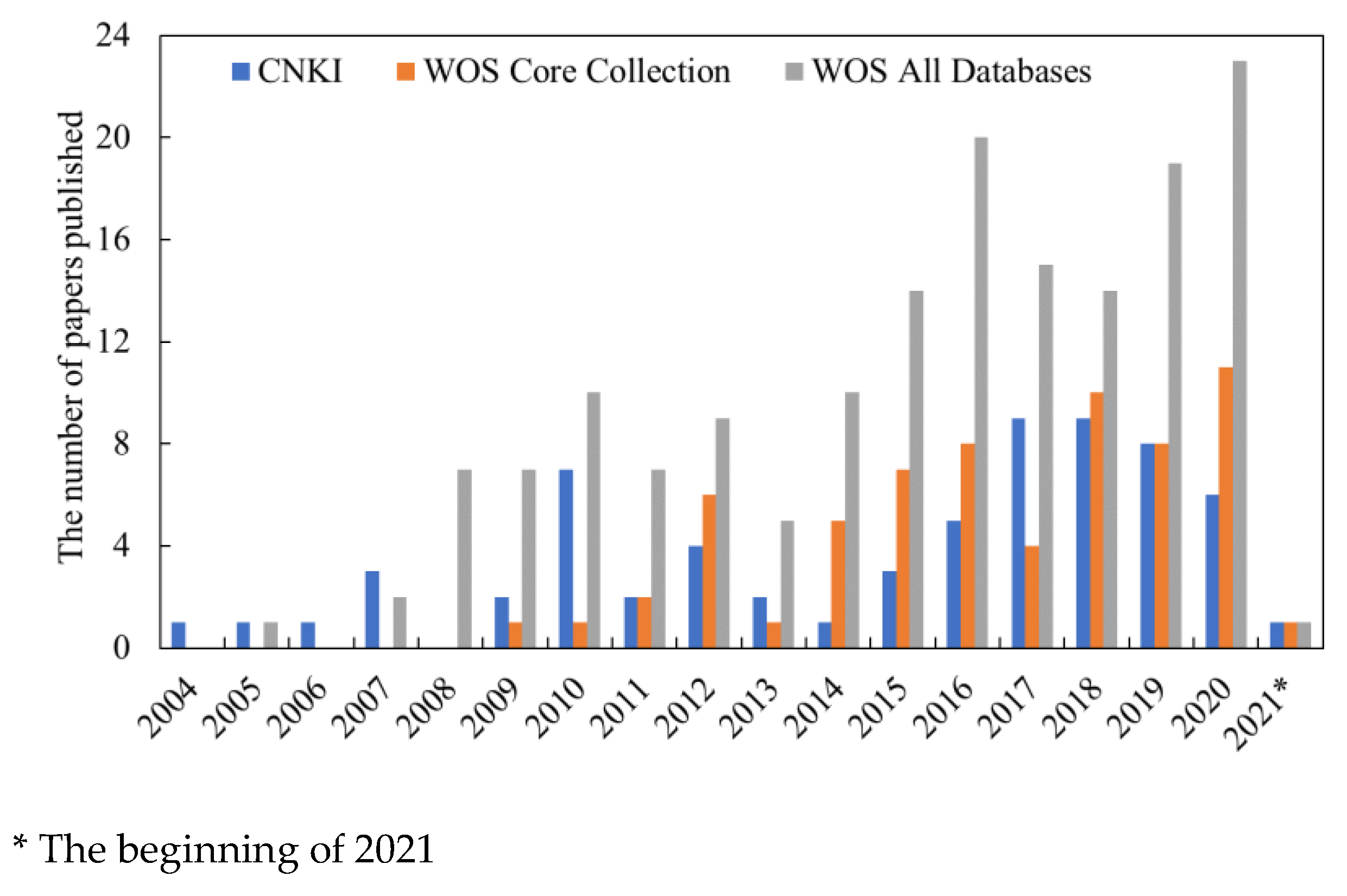

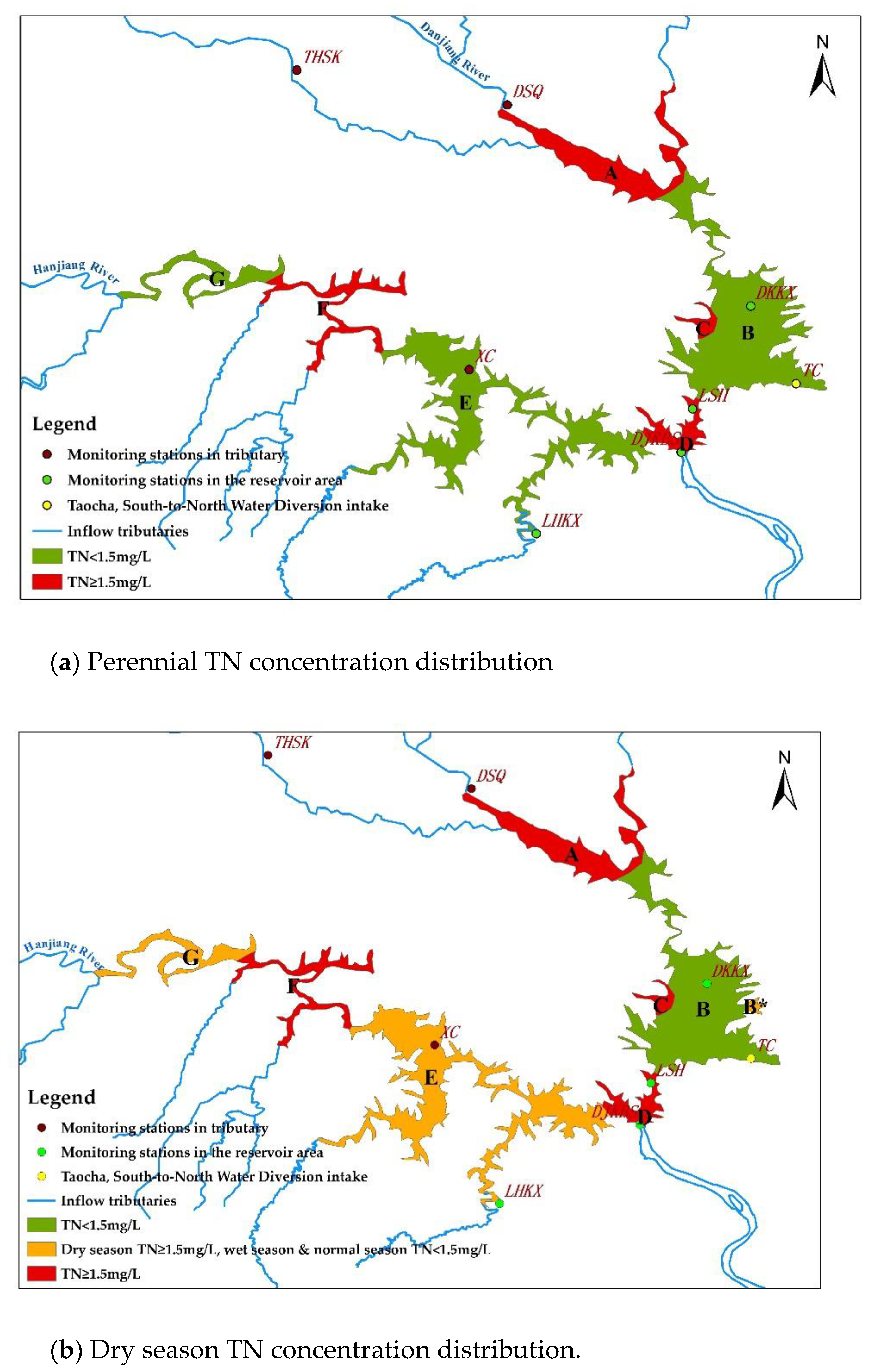
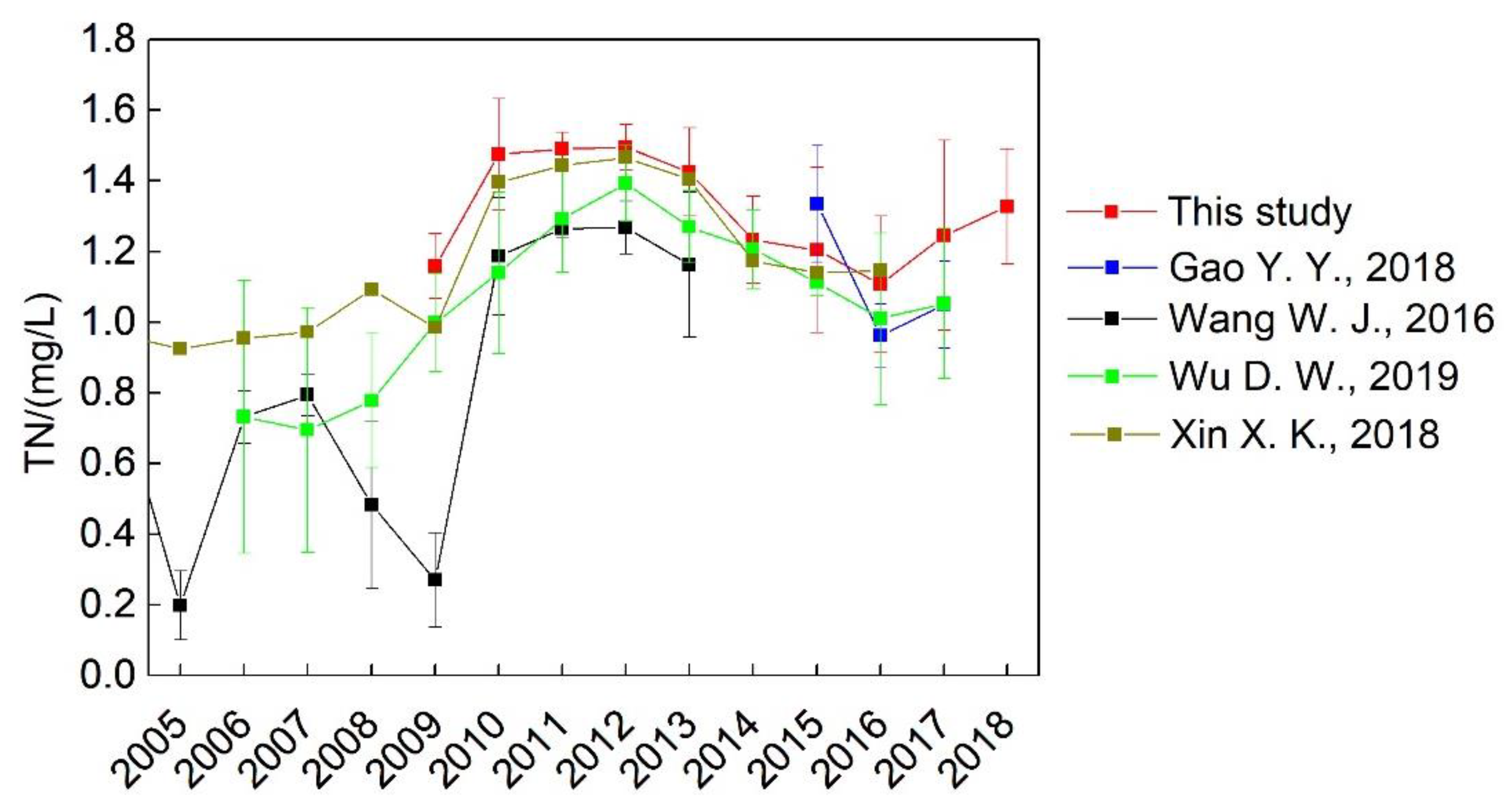
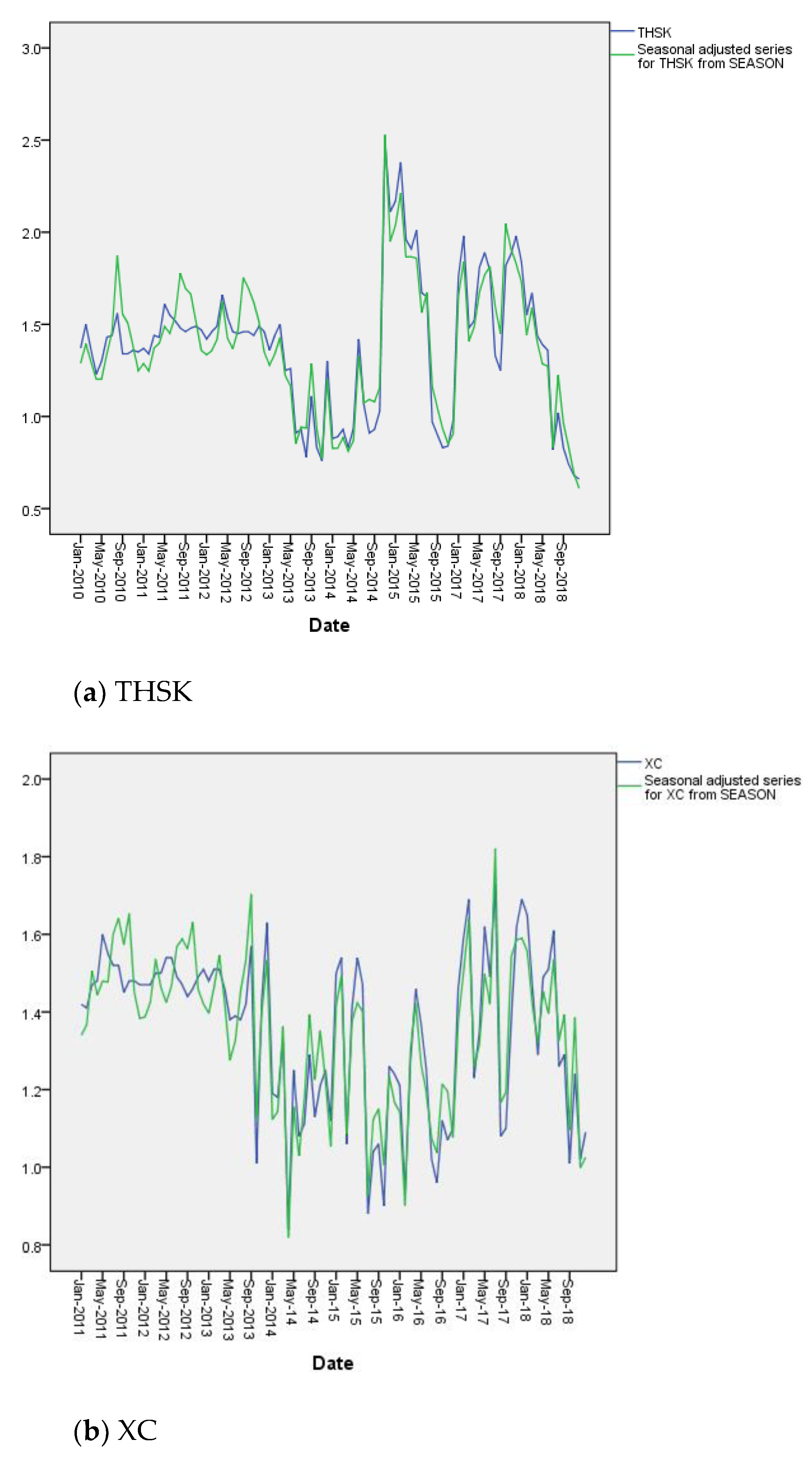
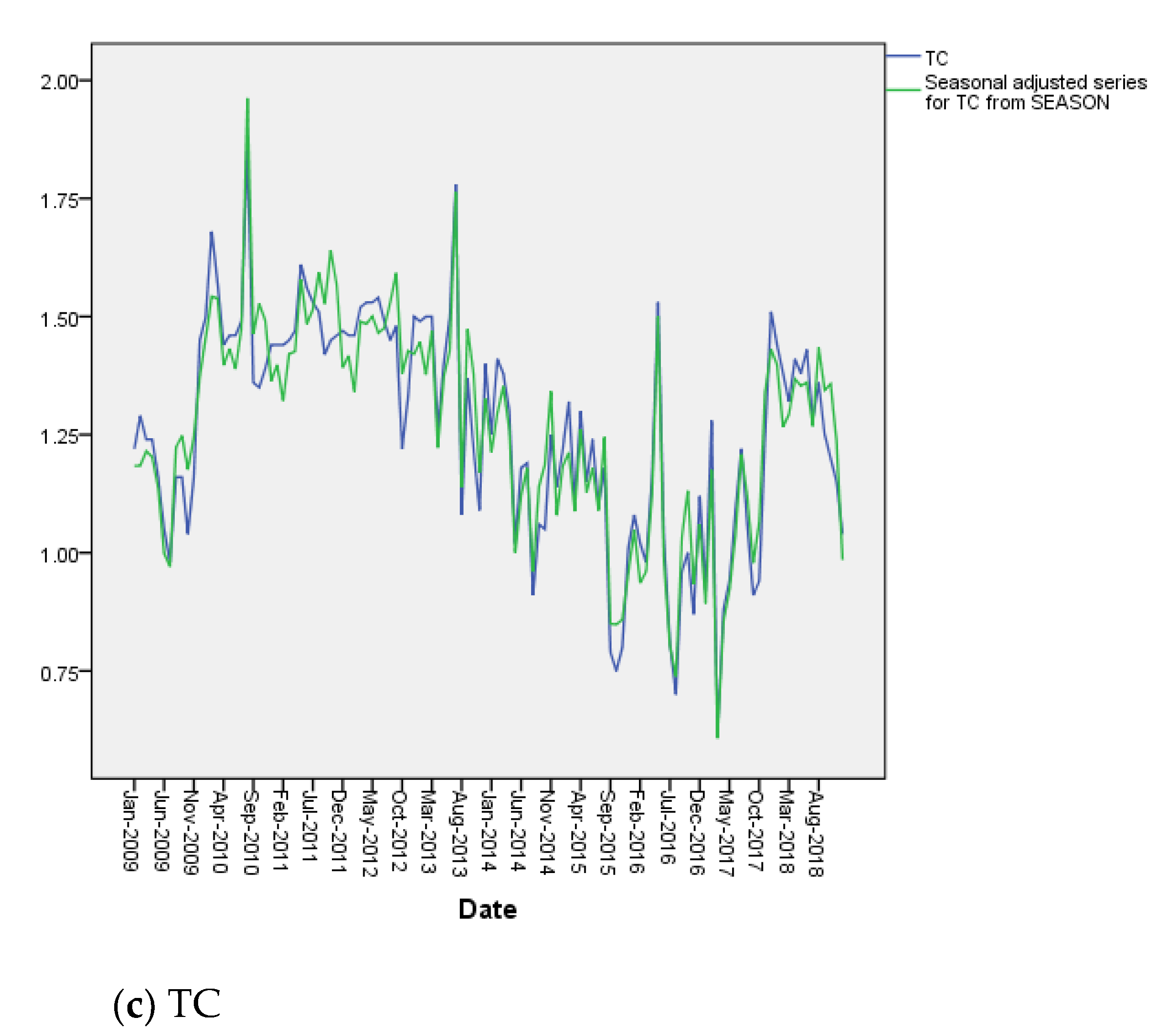

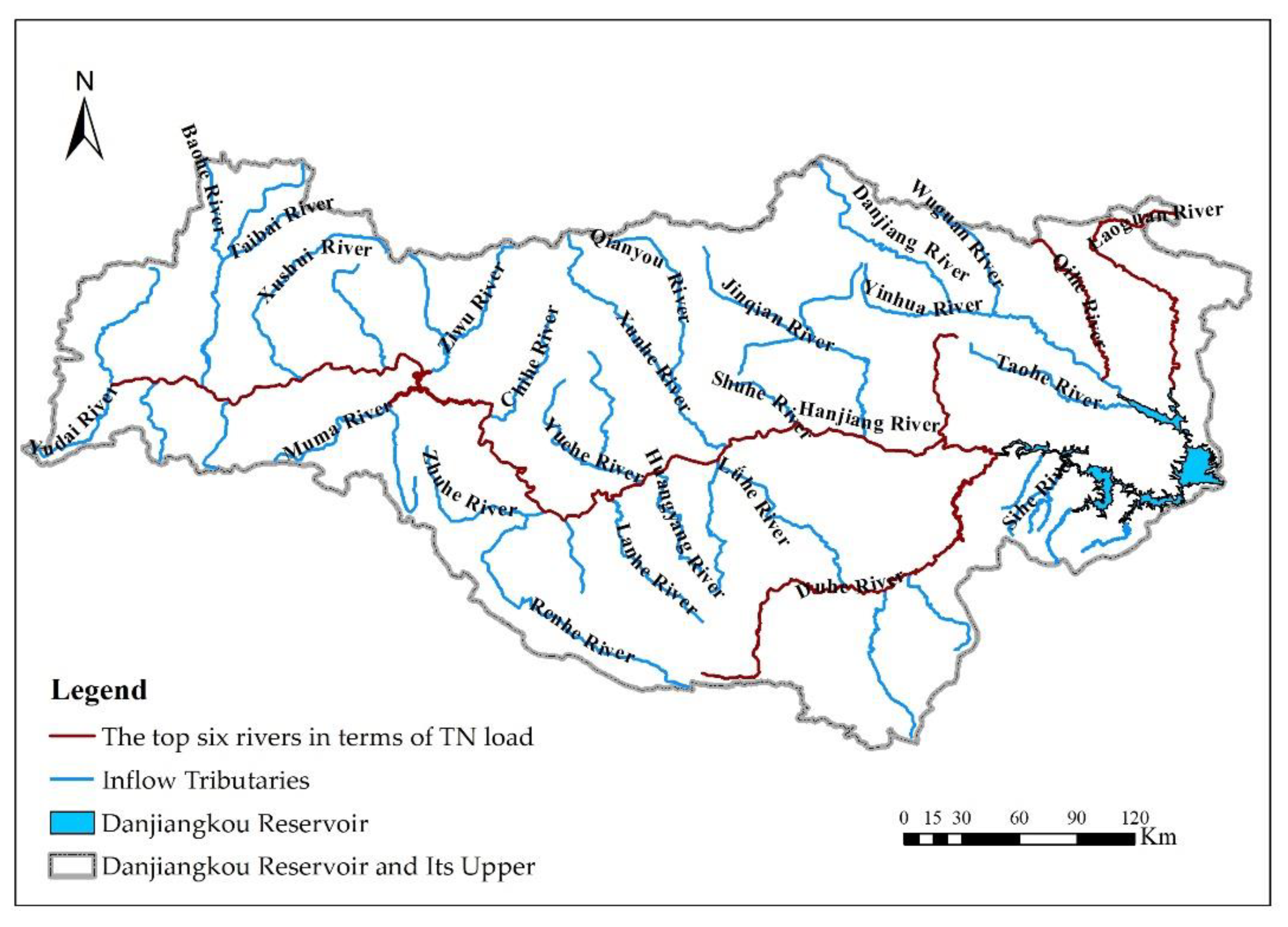
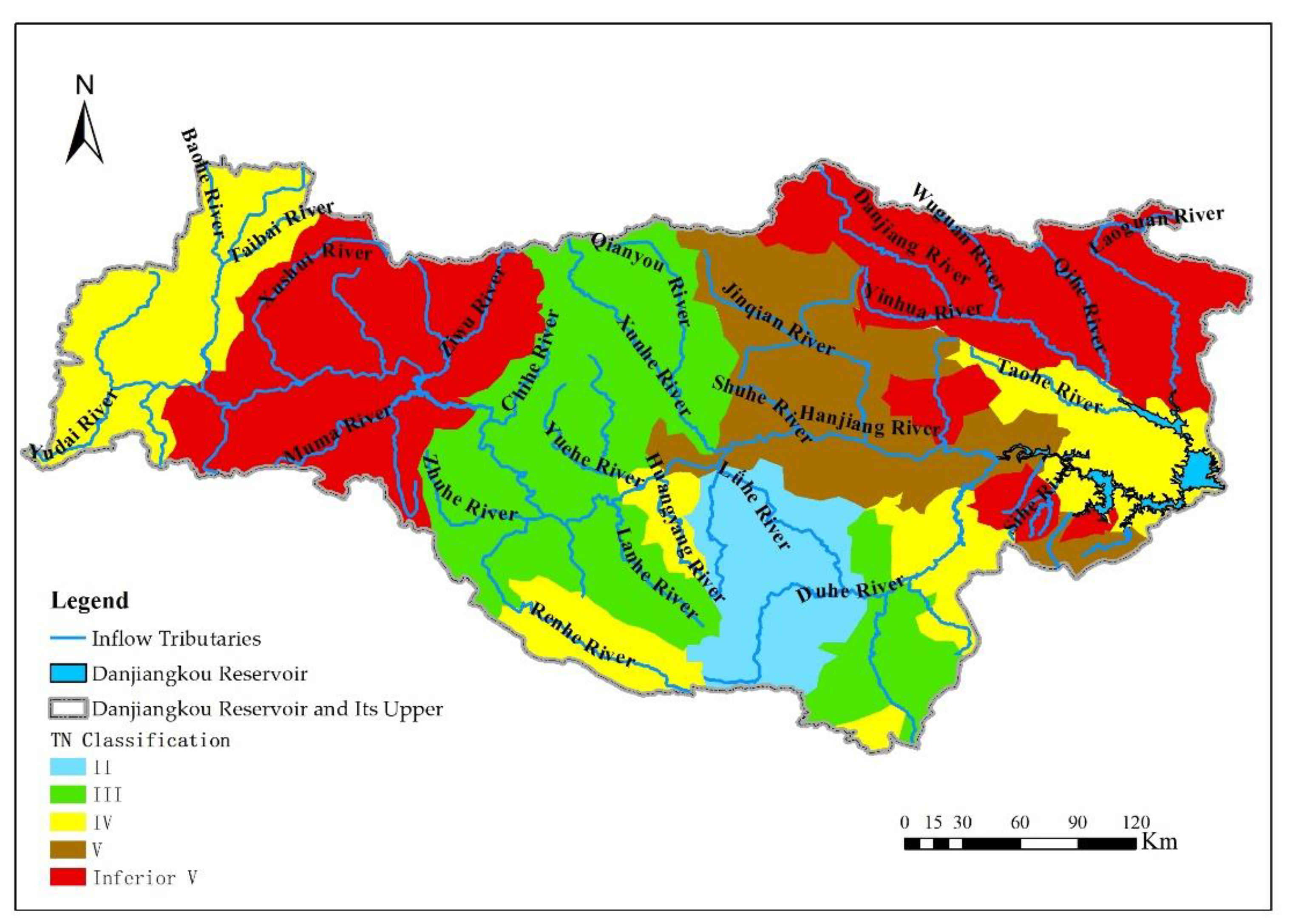
| Project | Class I | Class II | Class III | Class IV | Class V | |
|---|---|---|---|---|---|---|
| total nitrogen (TN) | <= | 0.2 | 0.5 | 1 | 1.5 | 2 |
| ammonia N (NH3-N) | <= | 0.15 | 0.5 | 1 | 1.5 | 2 |
| nitrate N (NO2-N & NO3-N) | <= | 10 (Standard limit of supplementary projects for surface sources of centralized drinking water) | ||||
| Inflow Tributaries | WATERSHED area/km2 | Mean Annual Discharge/100 million m3 | TN load/(t/a) | TN/(mg/L) | NH3-N/(mg/L) | NO3-N/(mg/L) | NO3-N Proportion/% | Presence or Absence of Main Inflow Tributaries | Pollution Degree |
|---|---|---|---|---|---|---|---|---|---|
| Hanjiang subreservoir | |||||||||
| Hanjiang River | 59,115 | 273.27 | 40,071.91 | 1.50 | 0.03 | 1.40 | 92.1 | Yes | - |
| Tianhe River | 1614 | 4.67 | 887.96 | 3.24 | 0.63 | 2.07 | 63.9 | Yes | - |
| Duhe River | 12,431 | 60.40 | 7237.52 | 0.96 | 0.05 | 0.85 | 88.3 | Yes | - |
| Shending River | 227 | 0.48 | 494.73 | 8.8 | 3.47 | 4.93 | 56 | - | Heavy |
| Jianghe River | 326 | 0.63 | 697.89 | 15.3 | 0.79 | 13.8 | 90.2 | - | Heavy |
| Sihe River | 469 | 1.14 | 1163.77 | 10.6 | 4.9 | 4.34 | 40.9 | - | Heavy |
| Guanshan River | 465 | 2.45 | 503.79 | 4.67 | 2.31 | 1.38 | 29.6 | - | - |
| Jianhe River | 47 | 0.10 | 41.51 | 3.78 | 0.38 | 2.84 | 75.1 | - | Heavy |
| Langhe River | 381 | 1.62 | 275.56 | 3.36 | 0.77 | 1.93 | 57.4 | - | - |
| Quyuan River | 312 | 0.55 | 80.57 | 2.2 | 0.54 | 1.3 | 59.1 | - | - |
| Jiangjun River | 62 | 0.14 | 21.39 | 2.18 | 0.04 | 1.94 | 89 | - | - |
| Taogou River | 45 | 0.11 | 13.78 | 0.81 | 0.03 | 0.73 | 90.2 | - | - |
| Danjiang Subreservoir | |||||||||
| Danjiang River | 7560 | 14.58 | 6175.46 | 6.13 | 0.04 | 4.83 | 78.8 | Yes | Heavy |
| Qihe River | 1598 | 3.82 | 661.73 | 6.09 | 0.06 | 4.42 | 72.6 | Yes | - |
| Taohe River | 1210 | 5.20 | 838.58 | 1.04 | 0.03 | 0.82 | 79.2 | - | - |
| Laoguan River | 4231 | 11.79 | 2180.01 | 9.76 | 6.32 | 1.46 | 15 | Yes | Heavy |
Publisher’s Note: MDPI stays neutral with regard to jurisdictional claims in published maps and institutional affiliations. |
© 2021 by the authors. Licensee MDPI, Basel, Switzerland. This article is an open access article distributed under the terms and conditions of the Creative Commons Attribution (CC BY) license (https://creativecommons.org/licenses/by/4.0/).
Share and Cite
Li, J.-J.; Dong, F.; Huang, A.-P.; Lian, Q.-Y.; Peng, W.-Q. The Migration and Transformation of Nitrogen in the Danjiangkou Reservoir and Upper Stream: A Review. Water 2021, 13, 2749. https://doi.org/10.3390/w13192749
Li J-J, Dong F, Huang A-P, Lian Q-Y, Peng W-Q. The Migration and Transformation of Nitrogen in the Danjiangkou Reservoir and Upper Stream: A Review. Water. 2021; 13(19):2749. https://doi.org/10.3390/w13192749
Chicago/Turabian StyleLi, Jin-Jin, Fei Dong, Ai-Ping Huang, Qiu-Yue Lian, and Wen-Qi Peng. 2021. "The Migration and Transformation of Nitrogen in the Danjiangkou Reservoir and Upper Stream: A Review" Water 13, no. 19: 2749. https://doi.org/10.3390/w13192749






